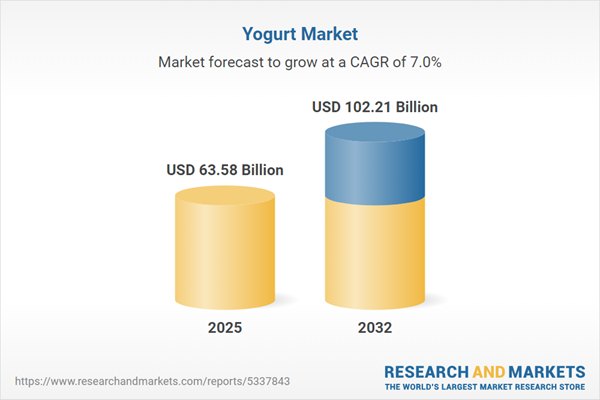Speak directly to the analyst to clarify any post sales queries you may have.
The U.S. yogurt market is evolving swiftly as companies adapt to shifting consumer expectations, regulatory frameworks, and sustainability imperatives. This comprehensive analysis equips senior executives with the insights needed to make informed strategic decisions and secure lasting growth in a highly competitive environment.
Market Snapshot: U.S. Yogurt Market Growth & Trends
The global yogurt market is expected to reach USD 63.58 billion in 2025, up from USD 59.44 billion in 2024, with a compound annual growth rate of 7.00%. Long-term estimates place the sector’s value at USD 102.21 billion by 2032. Market momentum is underpinned by robust demand for health-focused products, continuous innovation in both recipes and packaging, and a growing array of flavors targeting traditional and emerging consumer tastes. Leading companies are enhancing operational performance by embracing digital transformation and reinforcing omnichannel strategies. As consumer needs become more complex, the focus on agile supply chains and personalized experiences is elevating market competitiveness and efficiency.
Scope & Segmentation: Strategic Analysis of the U.S. Yogurt Market
- Product Types: Includes classic yogurt varieties and new functional options designed for consumers prioritizing health and wellness, addressing a broad range of preferences from traditional to lifestyle-oriented choices.
- Packaging Formats: Offers single-serve, drinkable, multipack, and pouch alternatives to support differing retail environments and fit varied consumption habits.
- Flavor Profiles: Spans plain, strawberry, and diverse regional flavors that engage both mainstream audiences and those keen to explore new tastes, enabling targeted portfolio growth.
- Fat Content: Features non-fat, low-fat, and whole-fat yogurts, helping producers cater to health-driven and more indulgent market segments alike.
- Distribution Channels: Covers advances in e-commerce, innovations in inventory and channel management, and integrated physical and digital sales to enhance market access and consumer convenience.
- Geographies: Focuses on the U.S. market while monitoring influential developments in China and India to support benchmarking and resilient supply strategies globally.
- Key Players: Highlights sector leaders such as Danone S.A., Inner Mongolia Yili, Nestlé S.A., General Mills, Groupe Lactalis, Müller Holding, Chobani LLC, Yakult Honsha, Arla Foods amba, and Grupo Lala, examining their alliances and integrated approaches to driving category performance.
Key Takeaways for Senior Decision-Makers
- Functional and plant-based innovations support diversified product portfolios, enhancing both consumer wellness and sensory appeal while emphasizing transparent ingredient labeling.
- Digital tools, such as automation and supply chain analytics, boost organizational agility and cost management, improving responsiveness to dynamic market and retail trends.
- Expanding omnichannel strategies increases consumer engagement by aligning logistics, messaging, and sales across digital and in-store platforms for broader reach and agility.
- Pursuing sustainability with recyclable and lightweight packaging strengthens regulatory compliance and appeals to environmentally conscious consumers seeking ethical product options.
- Biotech investments, collaborative business models, and sector consolidation enable producers to anticipate regulatory shifts more effectively and sustain market positioning.
Tariff Impact: Navigating New Trade Policy Pressures
Recent developments in U.S. tariff policy prompt yogurt producers to enhance sourcing flexibility and prioritize operational resilience. As trade dynamics affect materials pricing and supply chain continuity, agile scenario planning and tailored pricing frameworks are increasingly important in protecting margins and supply reliability. Companies are evaluating packaging innovation and alternative materials to further reduce exposure to volatility arising from shifting trade policies.
Methodology & Data Sources
This report draws on direct engagement with executive stakeholders, thorough cross-referencing by recognized product specialists, and independent validation from industry experts. Each recommendation derives from rigorous secondary research and multi-stage data verification to ensure the highest standard of executive guidance for the U.S. yogurt market.
Why This Report Matters
- Supports leadership in navigating market shifts and innovation, guiding strategic business planning and effective risk management.
- Equips teams with practical approaches for managing regulatory and trade-related risks, fostering agile responses to sector disruptions.
- Enables continuous product and operational adaptation to meet evolving consumer expectations and compliance requirements amid competitive pressures.
Conclusion
This analysis empowers senior leaders with actionable insights for navigating regulatory change, technological innovation, and consumer trends in the U.S. yogurt sector. Use these findings to strengthen strategic decision-making and secure your organization’s trajectory in a changing marketplace.
Additional Product Information:
- Purchase of this report includes 1 year online access with quarterly updates.
- This report can be updated on request. Please contact our Customer Experience team using the Ask a Question widget on our website.
Table of Contents
3. Executive Summary
4. Market Overview
7. Cumulative Impact of Artificial Intelligence 2025
Companies Mentioned
The companies profiled in this Yogurt market report include:- Danone S.A.
- Inner Mongolia Yili Industrial Group Co., Ltd.
- Nestlé S.A.
- General Mills, Inc.
- Groupe Lactalis
- Müller Holding GmbH & Co. KG
- Chobani LLC
- Yakult Honsha Co., Ltd.
- Arla Foods amba
- Grupo Lala, S.A.B. de C.V.
Table Information
| Report Attribute | Details |
|---|---|
| No. of Pages | 185 |
| Published | November 2025 |
| Forecast Period | 2025 - 2032 |
| Estimated Market Value ( USD | $ 63.58 Billion |
| Forecasted Market Value ( USD | $ 102.21 Billion |
| Compound Annual Growth Rate | 7.0% |
| Regions Covered | Global |
| No. of Companies Mentioned | 11 |









